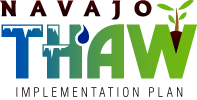Navajo face loss of elders and traditions to COVID-19
Yahoo News
By Issam Ahmed | June 4, 2020
Steamboat (United States) (AFP) - Emerson Gorman knows what it's like to face the destruction of his culture: when he was five-years-old he was among thousands of Navajo children taken from their families and sent to Christian schools that tried to erase their belief systems.
Now 66, the traditional healer who lives on the largest Native American reservation in the United States sees it as his duty to pass on his wisdom, at a time when the community elders face an existential threat from the coronavirus pandemic.
"It's very important to talk about our history, our rituals and ceremonies," said Gorman, a tall, well-built man with weathered features, who lives on a large homestead at the center of the Navajo Nation, where he and his family raise livestock and grow corn, fruit, and herbs.
Handing down the medicine he practices is particularly important, he says, because "we know that we're being taken care of and we're connected to the natural energy, to the spirits and the natural world."
A preponderance of poverty linked conditions like diabetes, obesity and heart disease -- combined with the fact that 30 to 40 percent of the Navajo Nation's population of 175,000 have no access to running water -- have made this territory one of the hardest hit zones in the US.
With more than 5,500 confirmed cases and 250 deaths, its per capita fatality rate lies just behind the state of New York, and much like everywhere else, it's the elderly who are the most impacted.
What makes things unique is the position the elderly hold in Native culture, as repositories of the community's knowledge which must be passed down orally to honor tradition.
"The fact that this illness is affecting elders disproportionately is very scary to native peoples. It's a huge source of anxiety," said Allison Barlow, director of the Johns Hopkins Center for American Indian Health (CAIH), which has worked in the territory since the 1990s.
"There was an era when the federal government suppressed the teaching of language, the teaching of culture," she told AFP, referring to Indian boarding schools, which ran from the 1860s to the late 1970s.
Teachers at the school attended by Gorman forced boys to cut their long braids, forbid them from speaking their language, told them that their religion was "evil" and tried to force them to convert to Catholicism.
- Loss of language -
In Monument Valley, one of the Navajo Nation's most iconic regions that is home to colossal sandstone formations , Lanell Mernard-Parrish, a treasurer for the local chapter of the Navajo government, is piling boxes into people's cars at distribution drive for those in need.
Vehicles carrying those aged 60 and above are identified by tape on their windshields -- volunteers cry "Elders!" when they come into view, and give them extra supplies, a sign of the high esteem they are held in.
Mernard-Parrish's voice breaks as she recaps a recent death in the family: that of her mother-in-law, who was 60.
"As soon as we found out she was ill, they took her in. And from the day that she was tested positive, she only stayed another six days, and then we lost her," said Mernard-Parrish, who is in her forties.
She is also sorry for her five children who have now lost a grandparent, a crucial link to their past.
Growing up, she said, "I was fortunate to have been around all four of my grandparents" -- but many of her generation lost their grandfathers early due to the expansive uranium mining that began in the Navajo Nation after World War Two.
According to researchers, the US government effectively carried out a mass human experiment on Navajo miners by failing to disclose the cancer risks of radiation while studying its impact on them.
"We're losing our language, and I think losing a grandparent has a lot to contribute to that," she said.
This is particularly the case for those Navajo who leave the reservation in search of economic opportunities and are no longer educated in Navajo schools or raised among the extended family.
- Revival efforts -
Back at their homestead, Gorman says he's been inundated with calls from people asking that he perform blessings to ward off COVID-19, often by phone.
He and his family follow official advice to wear face masks and wash their hands frequently.
But they also emphasize the use of herbs, pointing out the sage, yucca and juniper he grows to treat various ailments.
Back in 2004, his wife Beverly began a camp for the Nation's children to revive their culture and preserve tradition.
As a grandmother herself in a predominantly matriarchal society, she hands down the teachings of her foremothers.
Lessons include the Navajo language (Dine bizaad), history, herbs, rabbit trapping, making arrowheads and learning how to make fire with bow drills.
She has also set to song the "Blessingway" a prayer performed in the morning facing the rising sun in the east in order to bless and protect the home.
Naiyahnikai Gorman, 21, the youngest of Emerson and Beverly's eight children, wants to carry their legacy forward.
A research assistant at Johns Hopkins' CAIH, she is hoping to go to medical school and then start a center offering both Western and Navajo medicine.

